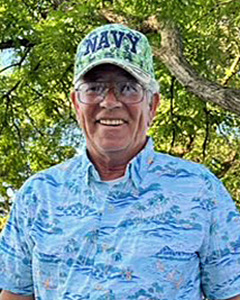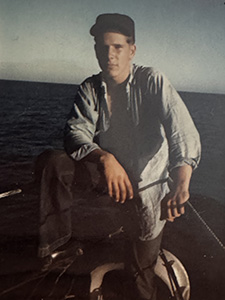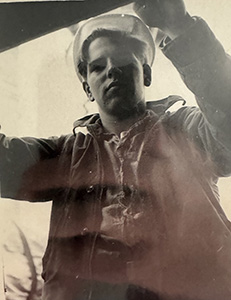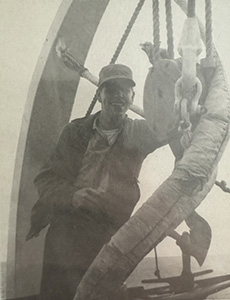Navy Vietnam War Naperville, IL Flight date: 10/23/24
By Mark Splitstone, Honor Flight Chicago Veteran Interview Volunteer
Both of Bob Falkman’s parents served in the US Army during World War II, his father as a lieutenant in the Supply Corps and his mother as a nurse. They met in Algiers and married shortly after returning home from overseas. Bob was born in 1948, and as he was growing up, the family moved around the Chicago area, but by Bob’s teenage years they were living in Maywood where he attended Proviso East high school. Bob had four brothers, one of whom served in the Navy and another who served in the Air Force. By the time Bob was finished with high school he had decided to enlist in the military.
In 1966 the Vietnam War was heating up, and Bob realized he’d prefer to have some distance between himself and the ground war. He therefore decided he didn’t want to be in the Army, and instead enlisted in the Navy at age 17. The fact that his older brother was already in the Navy made his decision easier. Bob says that his basic training, conducted in San Diego, wasn’t that difficult for him because he was already in good shape. The only challenge he faced was his weight. While many recruits needed to lose weight, Bob needed to gain it. He entered service at 5’9” and 125 pounds, but by the time he finished basic training he had added 20 pounds of muscle.
Bob completed basic training as a seaman and was sent to Naval Air Station Alameda on San Francisco Bay. He was assigned to the Boats and Docks unit, which performed a number of different roles on the base. They’d supply ships with pontoons if an oiler was servicing the ship, perform aircraft rescue, and do other types of salvage operations. He recalls one time a plane ran off the end of the runway so they had to execute a rescue. Another time a plane went down in a marshy area on Mare Island 30 miles north of Alameda and they had to salvage the plane. While at the base, Bob learned how to operate a Landing Craft Mechanized (LCM) boat.
After a year at Alameda, Bob was assigned to the destroyer USS Mansfield, where he’d spend the next two and a half years. The ship had been constructed in 1944 and had seen service in both World War II and Korea. Her home port was in Yokosuka, Japan, but from 1966 through 1970, the Mansfield spent most of her time in the South China Sea, interdicting supply boats attempting to get to the south, performing air-sea rescue, and providing gunfire support to ground troops. Bob estimates that while he was aboard, the Mansfield was off the coast of Vietnam about 75% of the time. He says that their captain was very gung-ho and preferred missions that involved shooting rather than providing logistical support or escorting carriers. While Bob was aboard, the Mansfield fired over 40,000 rounds, the most of any destroyer during that phase of the war. They were always on call to supply gunfire support to troops, usually Marines, who were fighting near the coast. Upon receiving a call, she’d head to the target area and fire. Sometimes the mission would call for only 30 or 40 rounds, but other times it was quite a bit more. As soon as they were done firing, they’d usually lay down a smoke screen and get out of the danger area as quickly as possible.
While targets were usually identified by spotters on the ground, the Mansfield had another target-spotting device. The Gyrodyne DASH was a helicopter drone that the Mansfield could launch from her deck to search for movement or other suspicious activity. Drones were a new technology in 1967 and unfortunately were prone to failure. Bob recalls on one occasion having to take his captain’s boat from the ship and searching unsuccessfully for a DASH that had crashed into the sea.
When cruising along the South Vietnamese coast, the Mansfield was fairly safe, but the same could not be said when they were cruising along the North Vietnamese coast. The range of the Mansfield’s five-inch guns was more than ten miles, significantly longer than that of the enemy’s three-inch guns, but that didn’t mean there wasn’t risk. Sometimes their mission would require them to sail close to the coast and within range of enemy batteries. On September 25, 1967, an enemy artillery shell landed amidships on the Mansfield, killing one sailor and injuring nineteen.




In part because of his experience operating LCM’s in Alameda, on the Mansfield Bob was assigned to run the captain’s gig, which was the ship’s boat. He was in charge of maintenance of the boat and was also its primary driver. He liked the role in part, he says, because of the fact that it got him out of a lot of other work. However when the ship fired its guns, which was often, everyone aboard, including Bob, would leave their usual roles and go to general quarters. Bob’s battle station was in a gun mount and he would stay there for as long as the ship was firing, usually around three hours. When there was a lot of shooting assignments or when they were on especially high alert, such as during the Tet Offensive, they’d go to what was called port and starboard. He’d then stay in general quarters for four hours, get a four-hour break, and then go back to general quarters for four hours for as long as the alert lasted.
The Mansfield would usually stay off the coast of Vietnam for several weeks and then go to a port. During his time aboard, Bob visited Taiwan, Hong Kong, the Philippines, Okinawa, Hawaii, Australia, and New Zealand. By the time the Mansfield completed its tour and returned to Long Beach in 1969, Bob was nearing the end of his enlistment period. Because he had enlisted at age 17, he was considered to be part of a program nicknamed the “kiddie cruise,” meaning he would be released the day before his twenty-first birthday. He still had a few months left and the Navy asked him if he wanted to re-enlist, but he decided that he’d had enough and therefore declined. To fulfill the rest of his commitment, he spent the next six months aboard a heavy cruiser, but it never left its port at Long Beach.
Bob returned to Chicago where he worked in a factory for a year before enrolling in college, first at a junior college and then at Lewis University. Even with the help of the GI bill, Bob always had to work while in school. After graduating with a degree in business administration, Bob spent most of his career in retail-related jobs, including management roles at Jewel and White Hen, as well as owning a White Hen franchise. Additionally, he and his wife started up and still own a successful business that provides competitive pricing information to retailers.
A couple years after returning from the war, Bob met his future wife Linda, and they’ve now been married for 52 years. They have two children who are now in their 40s, and five grandchildren who range in age from 12 to 17. Bob and Linda are fortunate that all their children and grandchildren live in Naperville so they’re able to see them quite often.
Bob enjoys golf, and in fact at various times throughout his career he’s worked in golf shops and a golf course. When weather permits he can be found on an area golf course three times a week. He is also a passionate motorcyclist and has owned a number of motorcycles over the years. He and Linda have ridden all over the country, from the Rocky Mountains to Washington, D.C., and he’s even had the honor of escorting funeral processions for veterans on a number of occasions. In total, he rode for over 100,000 miles, but recently decided to give it up. He realized that while he kept getting older, the bikes didn’t get any smaller. He offset the loss of his Harley Davidson motorcycle, though, by naming his dog Harley.
Bob often thinks back to his Navy days and considers it an honor to have served his country and believes that it was quite an experience. While he feels that it’s something he’d do all over again if he could, he adds that he wouldn’t have wanted to do it forever.


